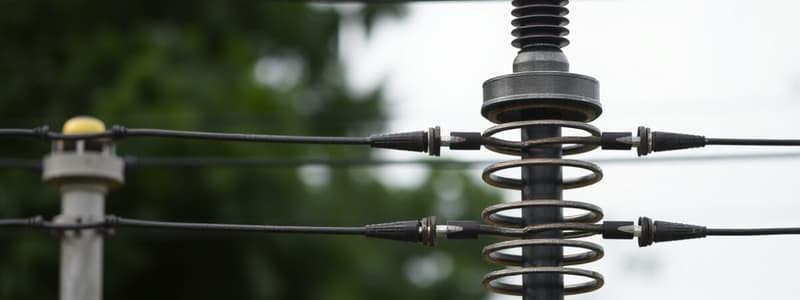Podcast
Questions and Answers
What is the primary function of insulators?
What is the primary function of insulators?
- To allow the free movement of electrons
- To conduct electricity efficiently
- To enhance the flow of electricity
- To prevent the transfer of electrical current (correct)
Which of the following materials is NOT considered an insulator?
Which of the following materials is NOT considered an insulator?
- Copper (correct)
- Wood
- Paper
- Rubber
How do conductors differ from insulators in terms of electron movement?
How do conductors differ from insulators in terms of electron movement?
- Conductors enable free movement of electrons (correct)
- Conductors have tightly bound electrons
- Insulators enhance electron mobility
- Insulators allow electrons to move freely
Why are rubber covers commonly used on wires?
Why are rubber covers commonly used on wires?
In an electric circuit, what happens if a conductor like a paperclip is inserted?
In an electric circuit, what happens if a conductor like a paperclip is inserted?
Which of the following best describes electrons?
Which of the following best describes electrons?
What is the main reason that humans can safely use household electric devices?
What is the main reason that humans can safely use household electric devices?
Which of the following is NOT a property of conductors?
Which of the following is NOT a property of conductors?
Which household item would function as a conductor?
Which household item would function as a conductor?
What concept is illustrated by comparing insulators to security guards?
What concept is illustrated by comparing insulators to security guards?
Flashcards
Insulators
Insulators
Materials that prevent or hinder the flow of electricity.
Electrons
Electrons
Negatively charged particles that orbit an atom's nucleus.
Electric Current
Electric Current
The movement of electric charge, typically caused by electrons flowing through a conductor.
Conductors
Conductors
Signup and view all the flashcards
Electric Circuit
Electric Circuit
Signup and view all the flashcards
Light Bulb
Light Bulb
Signup and view all the flashcards
Battery
Battery
Signup and view all the flashcards
Insulator materials
Insulator materials
Signup and view all the flashcards
Conductor materials
Conductor materials
Signup and view all the flashcards
Wires
Wires
Signup and view all the flashcards
Study Notes
Electrical Insulators
- Insulators prevent the flow of electricity.
- Insulators are materials with tightly bound electrons that restrict electron movement.
- Examples include rubber, wood, plastic, wool, silk, fur, oil, paper, and glass.
- Insulators, like security guards, prevent electricity from passing through.
Electrical Conductors
- Conductors allow the flow of electricity.
- Conductors are materials with loosely bound electrons that allow free electron movement.
- Examples include copper, silver, aluminum, nickel, iron, and paperclips.
- Conductors, like open doors, allow electricity to move through.
Electricity Transfer
- Electrons, negatively charged particles, are necessary for electricity.
- Free electron movement is key for the electricity to flow.
- Materials with tightly bound electrons restrict electron movement, hence they act as insulators.
- Materials with loosely bound electrons allow free electron movement, hence they act as conductors.
Electrocution
- Electrocution is the potentially deadly outcome of a powerful electric shock.
- Electrical wires are often insulated to prevent shock hazard.
- Insulators block dangerous current flow.
Semi-Conductors
- Some, like humans, are semi-conductors.
- Semi-conductors allow some but not as free electron movement as conductors.
- The human body can distribute charge, like from a Van de Graaff generator.
Studying That Suits You
Use AI to generate personalized quizzes and flashcards to suit your learning preferences.




